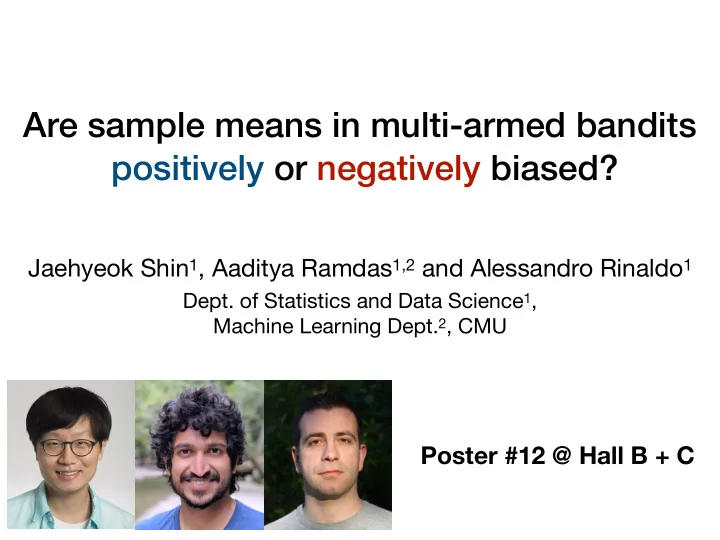

Are sample means in multi-armed bandits positively or negatively biased? Jaehyeok Shin 1 , Aaditya Ramdas 1,2 and Alessandro Rinaldo 1 Dept. of Statistics and Data Science 1 , Machine Learning Dept. 2 , CMU Poster #12 @ Hall B + C
Stochastic multi-armed bandit μ K μ 2 . . . μ 1 ∼ Y "Random reward"
Adaptive sampling scheme to maximize rewards / to identify the best arm Time μ K μ 2 μ 1 . . .
Adaptive sampling scheme to maximize rewards / to identify the best arm Time μ K μ 2 μ 1 . . . t = 1
Adaptive sampling scheme to maximize rewards / to identify the best arm Time μ K μ 2 μ 1 . . . t = 1
Adaptive sampling scheme to maximize rewards / to identify the best arm Time μ K μ 2 μ 1 . . . Y 1 t = 1
Adaptive sampling scheme to maximize rewards / to identify the best arm Time μ K μ 2 μ 1 . . . Y 1 t = 1 t = 2
Adaptive sampling scheme to maximize rewards / to identify the best arm Time μ K μ 2 μ 1 . . . Y 1 t = 1 t = 2
Adaptive sampling scheme to maximize rewards / to identify the best arm Time μ K μ 2 μ 1 . . . Y 1 t = 1 Y 2 t = 2
Adaptive sampling scheme to maximize rewards / to identify the best arm Time μ K μ 2 μ 1 . . . Y 1 t = 1 Y 2 t = 2 ⋮
Adaptive sampling scheme to maximize rewards / to identify the best arm Time μ K μ 2 μ 1 . . . Y 1 t = 1 Y 2 t = 2 ⋮ 𝒰 Stopping time
Collected data can be used to identify an interesting arm... Time μ K μ 2 μ 1 . . . Y 1 t = 1 Y 2 t = 2 ⋮ 𝒰 "Interesting!"
̂ ...and data can be used to estimate the mean. Time μ K μ 2 μ 1 . . . Y 1 t = 1 Y 2 t = 2 ⋮ 𝒰 Sample mean μ κ ( 𝒰 ) of chosen arm κ
̂ Q. Bias of sample mean? 𝔽 [ μ κ ( 𝒰 ) − μ κ ] ≤ or ≥ 0?
̂ Nie et al. 2018 : Sample mean is negatively biased. 𝔽 [ μ k ( t ) − μ k ] ≤ 0
̂ Nie et al. 2018 : Sample mean is negatively biased. 𝔽 [ μ k ( t ) − μ k ] ≤ 0 Fixed Arm Fixed Time
̂ ̂ Nie et al. 2018 : Sample mean is negatively biased. 𝔽 [ μ k ( t ) − μ k ] ≤ 0 Fixed Arm Fixed Time This work : Sample mean of chosen arm at stopping time 𝔽 [ μ κ ( 𝒰 ) − μ κ ] Chosen Arm Stopping Time
̂ This work : Sample mean of chosen arm at stopping time is ... 𝔽 [ μ κ ( 𝒰 ) − μ κ ]
̂ This work : Sample mean of chosen arm at stopping time is ... 𝔽 [ μ κ ( 𝒰 ) − μ κ ] (a) negatively biased under ‘optimistic sampling'.
̂ This work : Sample mean of chosen arm at stopping time is ... 𝔽 [ μ κ ( 𝒰 ) − μ κ ] (a) negatively biased under ‘optimistic sampling'. (b) positively biased under ‘optimistic stopping’.
̂ This work : Sample mean of chosen arm at stopping time is ... 𝔽 [ μ κ ( 𝒰 ) − μ κ ] (a) negatively biased under ‘optimistic sampling'. (b) positively biased under ‘optimistic stopping’. (c) positively biased under ‘optimistic choosing’.
Monotone effect of a sample Theorem [Informal] 1 ( κ = k ) Sample from arm k N k ( 𝒰 )
Monotone effect of a sample Theorem [Informal] 1 ( κ = k ) Positive bias Sample from arm k N k ( 𝒰 ) Increasing
Monotone effect of a sample Theorem [Informal] 1 ( κ = k ) Positive bias Sample from arm k Negative bias N k ( 𝒰 ) Increasing Decreasing
Monotone effect of a sample Theorem [Informal] 1 ( κ = k ) Positive bias Sample from arm k Negative bias N k ( 𝒰 ) Increasing Decreasing Agnostic to algorithm
Monotone effect of a sample Theorem [Informal] 1 ( κ = k ) Positive bias Sample from arm k Negative bias N k ( 𝒰 ) Increasing Decreasing Agnostic to algorithm Includes Nie et al. 2018 as a special case
Monotone effect of a sample Theorem [Informal] 1 ( κ = k ) Positive bias Sample from arm k Negative bias N k ( 𝒰 ) Increasing Decreasing Agnostic to algorithm Includes Nie et al. 2018 as a special case Positive bias under best arm identification, sequential testing
Poster #12 @ Hall B + C Are sample means in multi-armed bandits positively or negatively biased? Jaehyeok Shin, Aaditya Ramdas and Alessandro Rinaldo
Recommend
More recommend